november 8th, 2010
Rinus Van de Velde
Physical Items Themselves Are Not Evidence, 2009
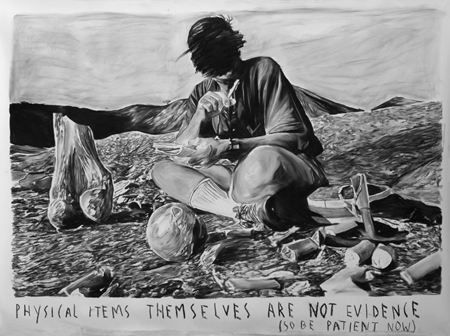
Rinus Van de Velde uses signs as a means to put a recalcitrant reality in order. His starting point is shaped through the world of photographic representation. Having an extensive personal archive of images ranging from (semi)scientific magazines such as the National Geographic to biographies of artists and scientists, these images form a rich source for series of drawings in which the source material is still recognizably present. The resemblance between all these pictures is not so much what they show but how they show it. By using the photographs as material for a drawing and by situating it in a different context by adding text, Van de Velde ignores the facts and creates space to tell a personal story. The aim isn’t to tell the reality behind the photo but to create third degree myth. Many of the photographs that Van de Velde references are part of an ideology that isn’t completely right or which hasn’t survived the test of time: like the deep rooted faith in the myth of the artist as authentic or autonomous, scientific progress or paternal exotism. Instead of dismantling, Van de Velde weaves through text and reciprocally references a new story. The result is a sort of mirror-universe, inhabited by brave alter-egos that map the world around them and function as ideal representatives of the actual artist.
When Suddenly It Hit Me, 2009
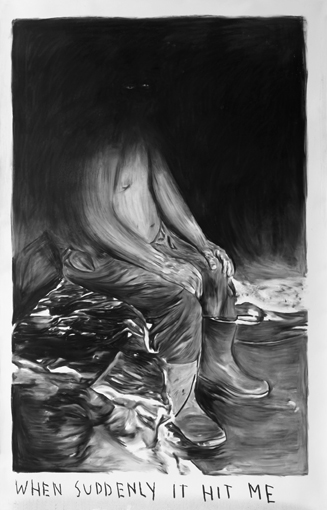
Maarten Vanden Eynde
Dip-Stick, 2005
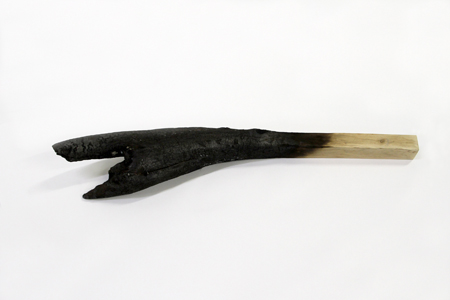
Small wooden sculpture, planed square on one side, the other is inflicted like a burned lump or black tumor, like a stick dipped in dark matter.
Posted in Cosmology, Pyrography, Visual Arts | Reacties uitgeschakeld voor When Suddenly It Hit Me
september 19th, 2008
DRAW ME A SHEEP
Square Tree Trunk, 2008

Square Tree Trunk series are a part of NATURE V2.01 project. ‘Round’ is perfect in nature, but ‘square’ is perfect for industrial standard. To illustrate, square tree would enable wood industry to lose less material, to cut easier with machines and to store more efficiently.
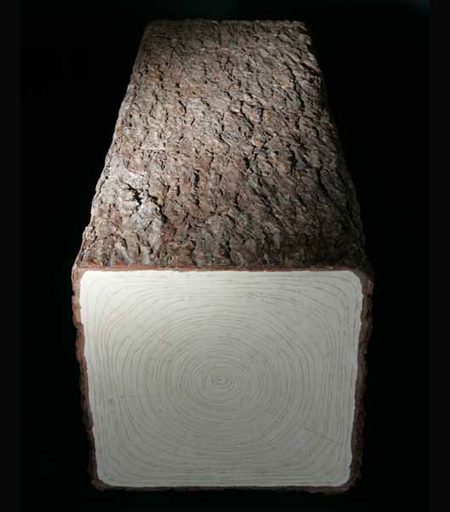
Maarten Vanden Eynde
Bonfire: Rite for Almere, 2008
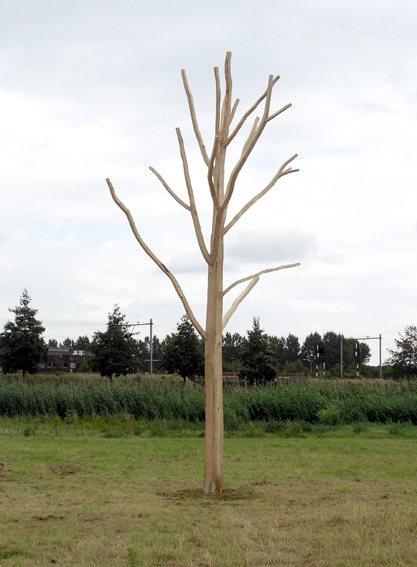
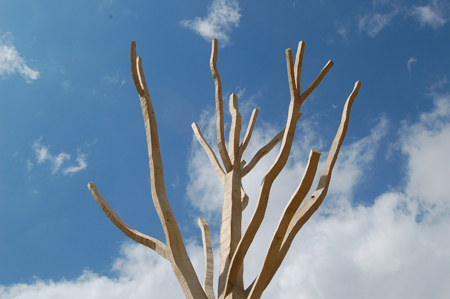
All over the world rites and celebrations form the backbone of a society and function as cornerstones of history. The rite is an event to remember or look forward to. An occasion to create a moment of reflection, an enlarged presence of the present, the ideal opportunity to commemorate once past and plan the future. It is an event of which if you are part of that particular society, you just have to be there. Sometimes the initial history of the rite is lost but still continued because it is part of everybodies life. Since Almere lacks a history (beyond 30 years) I thought of giving it one by initiating a rite. An oak tree from the first generation of planted trees in Almere (about 35 years old) was cut square, like a big beam splitting up in smaller beams, covered with dry pinewood and lit on the 21st of August 2008 at 21.00. The tree will stay for a few years as semi-permanent sculpture and will be relit every year untill it only exists in stories.



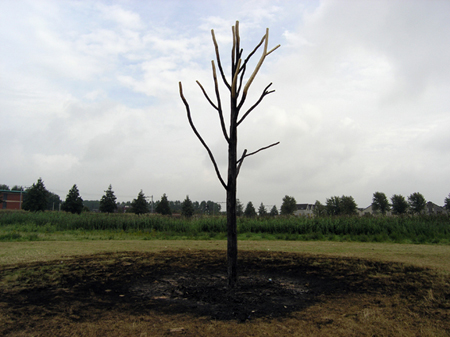
Posted in Dendrology, Ecology, Pyrography, Visual Arts | Reacties uitgeschakeld voor Modernistic Tree
maart 12th, 2008
Cornelia Parker
Cold Dark Matter: An Exploded View, 1991
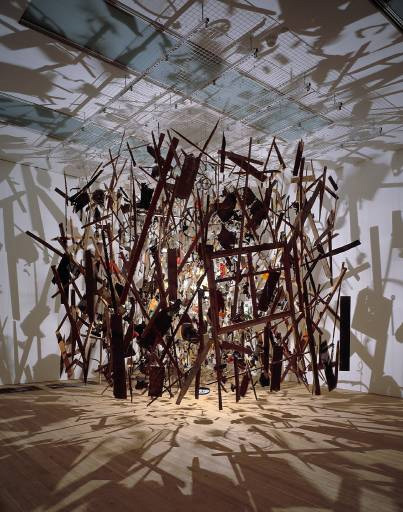
Cold Dark Matter began life as a garden shed filled with objects from her own and friends’ sheds and things bought at a car boot sale. She then asked the army to blow up the shed under very controlled conditions. The objects, along with the fragments of the shed, were collected and suspended in a closed room in an attempt to recreate the moment just after the explosion. The installation is lit with a single light-bulb at the very centre of the arrangement, casting shadows on the walls. The title gives us a whole new way of understanding the artwork, making us think of other dramatic moments of destruction and creation in the much wider universe.
Neither From Nor Towards, 1992
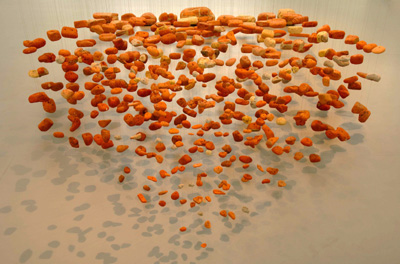
In ‘Neither From Nor Towards’ the brick remnants of an eroded house hang suspended in stilled animation in the work of British artist Cornelia Parker, who was nominated for the Turner prize in 1997. Her work often depicts a moment in time, which has been halted. In ‘Neither From Nor Towards’, the bricks are resonant with their previous life, reminding us of the passage of time over which we have no control. Parker rescues and reinterprets the ordinary, which is transformed by the gallery setting into something poetic and extraordinary.
Heart of Darkness, 2004
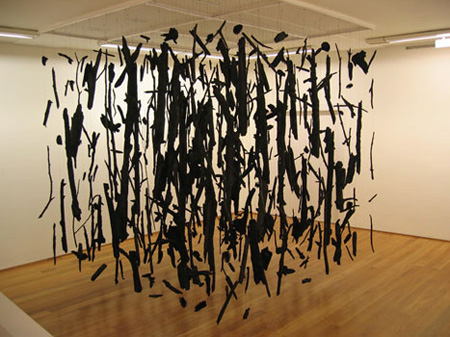
Charcoal from a Florida Wildfire (planned forest burn that got out of control)
Cornelia Parker was born in Cheshire in I956 and lives and works in London. She is interested in how everyday objects can be changed by (often violent) processes. During her career she has used a steamroller to flatten silver plates and has transformed a wedding ring into metres of fine, gold thread. Although at first glance it might seem that she is interested in destroying objects, she is in fact fascinated by how change can create something completely new.
Posted in Archaeology, Cosmology, Eschatology, Pyrography, Visual Arts | Reacties uitgeschakeld voor Cold Dark Matter
februari 19th, 2006
The Three Body Problem is the mathematical problem of finding the positions and velocities of three massive bodies, which are interacting each other gravitationally, at any point in the future or the past, given their present positions, masses, and velocities. An example would be to completely solve the behavior of the Sun-Jupiter-Saturn system, or that of three mutually orbiting stars. It is a vastly more difficult exercise than the two-body problem. In fact, as Henri Poincaré (1854-1912) and others showed, the three-body problem is impossible to solve in the general case; that is, given three bodies in a random configuration, the resulting motion nearly always turns out to be chaotic: no one can predict precisely what paths those bodies would follow.
Watch here: The Tree Body Problem animation
Genetologic Research Nr. 6, 2003 (300cm x 300cm x 300cm)
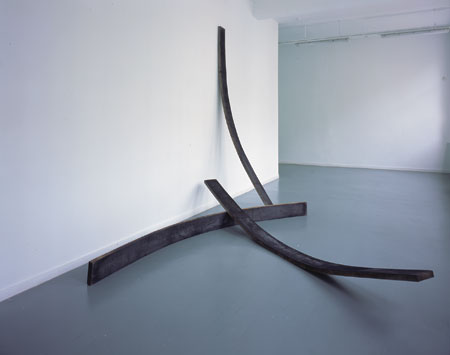
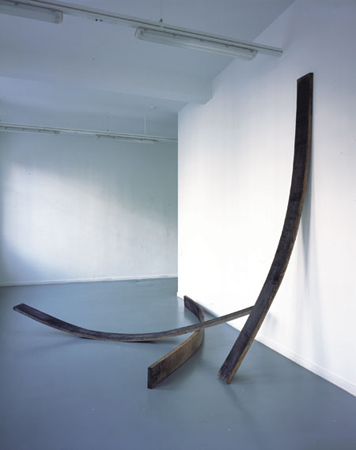
Maarten Vanden Eynde
Three wooden (oak) beams are manually bended by fire and water during a three week lasting ’torture-session’. After being liberated from the bending-machine, the beams stay in their forced position. The thee bodies are photographed in a certain way, but can change position without loosing their inter-relating balance. Various positions have been tried and just a few points of view bring them into a harmonious equilibrium. Any change or random elaboration creates chaos or disharmony.
Posted in Mathematics, Pyrography, Visual Arts | Reacties uitgeschakeld voor The Three Body Problem















